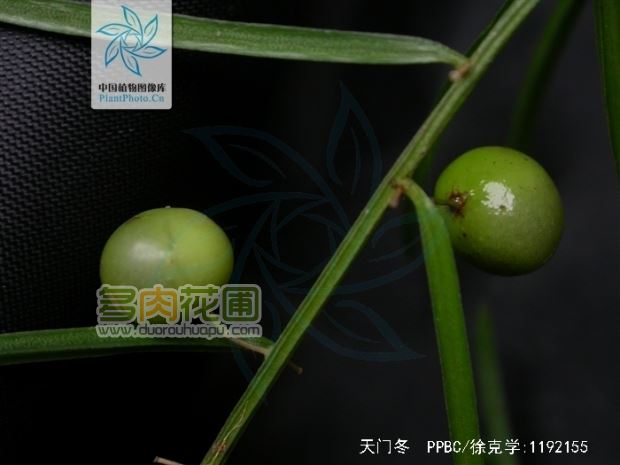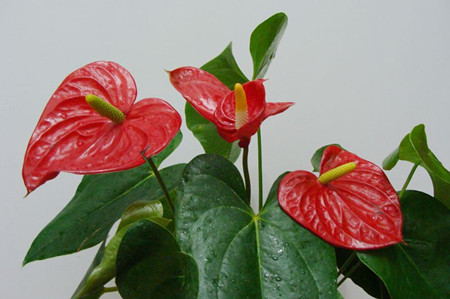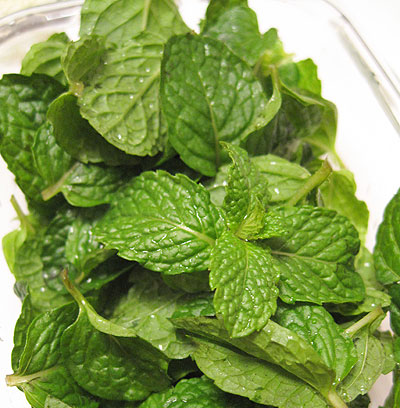Cultivation methods and precautions of asparagus
Tianmen winter is known as asparagus. It is a perennial semi-vine green herb of Liliaceae. Having a spindle shape such as a tuberous root. Leafy branches linear, clustered, flowers white or reddish, berries bright red.
Like warm and humid environment, like sunshine, resistant to semi-shade, afraid of direct light. It is advisable to loosen the sandy loam with fertile soil and good drainage. In the north, the cultivation of Tianmen winter is more than the middle and late April to change the basin. When changing the basin, cut off some of the old roots and add the culture soil mixed with 4 parts of rotten leaf soil, 4 parts of garden soil and 2 parts of river SARS.
Water thoroughly every 2-3 days in spring. At this time, if the air is dry, water should be sprayed on the plant every day and water should be sprayed on the ground around the maintenance site every day; in summer, water should be sprayed for 2 to 3 days to increase air humidity. Tianmen winter is fleshy root, afraid of waterlogging, usually watering should not be too much; water every day in summer.
The vigorous growth period is from May to September, and the rotten cake fertilizer and water can be applied every 15 to 20 days. If the indoor light is insufficient, it should be kept outdoors for maintenance for a period of time in spring and autumn; in winter, where the indoor light is sufficient, the room temperature should be kept above 5 degrees Celsius, water should be watered every 10 to 15 days, and secondary branches and leaves should be sprayed and washed every 3 to 5 days.

1. Morphological characteristics.
Climbing plants. The roots are fusiform in the middle or near the end, most of which are 3-5 cm long and 1-2 cm thick. Stems smooth, often curved or twisted, up to 1-2 m long, branched angulate or narrowly winged. Leafy branches usually clustered every 3, flattened or slightly sharply trigonous due to keel of midrib, slightly falcate, 0.5-8 cm long and ca. 1-2 mm wide; scalelike leaves on stems extend into hard spines 2.5-3.5 mm long, thorns on branches shorter or inconspicuous. Flowers usually 2 axillary, light green; pedicels 2-6 mm long; joints generally located in the middle, sometimes changing position; male flowers: perianth 2.5-3 mm long; filaments not Adnate to perianth segments; female flowers similar in size to male flowers. Berries 6-7 mm in diameter, red when ripe, with 1 seed. The flowering period is from May to June and the fruiting period is from August to October.
2. Growth environment
Born in a damp place in the mountains. Growing in an area of 1750 meters above sea level, it generally grows on roadsides, hillsides, valleys, sparse forests and wasteland, and has not yet been artificially introduced and cultivated. Tianmeng has strong adaptability, extensive management, easy cultivation, and is suitable for family maintenance. Tianmen winter likes fertile sandy soil, which is suitable for humid climate and environment, but is afraid of waterlogging and hot sun. Like warm and humid climate, not resistant to cold, avoid drought and stagnant water. It is suitable to select loam or sandy loam which is deep, fertile, rich in humus and well drained, but not in clay or barren soil and areas with poor drainage.
3. Geographical distribution
It is distributed in the south of Hebei, Shanxi, Shaanxi and Gansu provinces to the provinces and regions of East China, South Central and Southwest China. Born on slopes, roadsides, under sparse forests, valleys or wasteland below 1750 meters above sea level. It is also found in North Korea, Japan, Laos and Vietnam.
4. Cultivation techniques
The method of planting is to propagate with seeds or ramets. Seed propagation, seedling transplanting method: from July to August, when the fruit changes from green to yellow, harvest, rub off the pulp, wash clean, select seeds with large, full, dark and shiny seeds. Spring sowing is from March to April, and autumn planting is from August to September. In areas where there is no frost or short frost period, autumn sowing has high germination rate and strong growth. Spring sowing seeds are stored in 2-3 times wet sand for the winter; before sowing, 30% shade is selected as the bed under the tree, or a shed can be built for shade. Open a horizontal ditch on the border surface, row spacing 17-20cm, sowing width 8-10cm, depth 3.5 cm; spread seeds evenly in the ditch, cover fine soil or mixed soil fertilizer mixed with plant ash, and then cover with thin grass to moisturize. It was cultivated for 1-2 years and transplanted before sprouting in October or spring. The row spacing was (30-40) cm × (20-25) cm. Before the plant germinated in March-April, the roots were dug out and divided into 3-5 clusters with 1-2 buds in each cluster, and planted in holes with a row distance of 30cm × (20-25) cm, kept moist and emerged in 10-15 days.
Field management carried out intertillage weeding three times a year, the first time in March-April; the second time in June-July, topdressing human and animal manure water, but also appropriate application of ammonium sulfate and urea; the third time in September-October, applying soil and miscellaneous fertilizer. When the vine stem grows to the 50cm or so, set up a support or pillar to make it winding to facilitate growth.
Pest control of short beard mites, May-June for the harmful leaves, with 40% isocarbophos 1500 times solution or 20% diformamidine EC 1000 times solution spray control.
Culture methods and matters needing attention of Tianmen winter
Soil requirements of Tianmen Winter
Like the warm and humid environment, like the sun, resistant to semi-shade, afraid of direct light. It is advisable to loosen the sandy loam with fertile soil and good drainage. In the north, the cultivation of Tianmen winter is more than the middle and late April to change the basin. When changing the basin, cut off some of the old roots and add the culture soil mixed with 4 parts of rotten leaf soil, 4 parts of garden soil and 2 parts of river SARS.
Watering method of Tianmen winter
Water thoroughly every 2-3 days in spring. At this time, if the air is dry, it is necessary to spray water on the plant every day to sprinkle water on the ground around the maintenance site; in summer, spray water every 2-3 days to increase air humidity. Tianmen winter is fleshy root, afraid of waterlogging, usually watering should not be too much; water permeable once a day in summer.
Fertilization methods of Tianmeng
The period of vigorous growth is from May to September, and rotten cake fertilizer and water can be applied every 15 to 20 days. If the indoor light is insufficient, it should be kept outdoors for a period of time in spring and autumn; in winter, where the indoor light is sufficient, the room temperature should be kept above 5 ℃, water should be watered every 10 to 15 days, and branches and leaves should be sprayed and washed every 3 to 5 days.
The breeding method of Tianmeng
Tianmen winter reproduction can be combined with the change of pot in spring, the mother plant should be more than 3 years old, when dividing, the mother plant should be taken out of the pot, according to the size of the plant cluster. Several pots were planted, watered thoroughly and placed in the semi-shade for 15 days. the seeds matured at the end of December, soaked in water after harvest, rubbed the peel and dried in the sun. Spring sowing, the indoor temperature should not be lower than 15 ℃, it can germinate in a month, and the seedlings will be planted separately when they are about 4ml 5cm long, with several plants in each pot.
- Prev

Culture method of Anthurium andraeanum (Flaming Crane)
The flaming crane is called candle, anthurium, andrographis angustifolia. The flowers are drawn from the leaves like flaming cranes. The flower has a waxy texture, a long flowering period, and can blossom year-round under suitable conditions. It is a new species of cut and potted flowers in the world.
- Next

Culture methods and matters needing attention of Peppermint
Peppermint is a perennial root herb with fragrant and cool taste. With creeping rhizomes with nodes, each node with two opposite buds and bud scales. The stem is quadrangular, erect, the upper part is velutinous, and the lower part has only a few hairs along the ribs. Leaves opposite, oblong-lanceolate to elliptic, 8-10 cm long
Related
- Fuxing push coffee new agricultural production and marketing class: lack of small-scale processing plants
- Jujube rice field leisure farm deep ploughing Yilan for five years to create a space for organic food and play
- Nongyu Farm-A trial of organic papaya for brave women with advanced technology
- Four points for attention in the prevention and control of diseases and insect pests of edible fungi
- How to add nutrient solution to Edible Fungi
- Is there any good way to control edible fungus mites?
- Open Inoculation Technology of Edible Fungi
- Is there any clever way to use fertilizer for edible fungus in winter?
- What agents are used to kill the pathogens of edible fungi in the mushroom shed?
- Rapid drying of Edible Fungi

